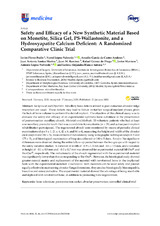Safety and Efficacy of a New Synthetic Material Based on Monetite, Silica Gel, PS-Wallastonite, and a Hydroxyapatite Calcium Deficient: A Randomized Comparative Clinic Trial
Autor
Flores Fraile, Javier
López-Valverde, Nansi
García de Castro Andews, Arcadio
Santos Marino, Juan Antonio
Ramírez, Juan M.
Gómez de Diego, Rafael
Montero, Javier
López-Valverde, Antonio
Blanco Antona, Leticia Alejandra
Editor
MDPIFecha
2020Materia
Bone substitutePost-extraction socket
Alveolar preservation
Controlled clinical trial
METS:
Mostrar el registro METSPREMIS:
Mostrar el registro PREMISMetadatos
Mostrar el registro completo del ítemResumen
Background and Objectives: Maxillary bone defects related to post-extraction alveolar ridge resorption are usual. These defects may lead to failure in further surgical implant phases given the lack of bone volume to perform the dental implant. The objective of this clinical assay was to evaluate the safety and efficacy of an experimental synthetic bone substitute in the preservation of post-extraction maxillary alveoli. Materials and Methods: 33 voluntary patients who had at least one maxillary premolar tooth that was a candidate for exodontia (n = 39) and subsequent implant rehabilitation participated. The regenerated alveoli were monitored by means of periodic clinical examinations (days 9 ± 1, 21 ± 4, 42 ± 6, and 84 ± 6), measuring the height and width of the alveolar crest (days 0 and 180 ± 5), measurement of radiodensity using tomographic techniques (days 0–5 and 175 ± 5), and histological examination of biopsies collected at 180 ± 5 days. Results: No significant differences were observed during the entire follow-up period between the two groups with respect to the safety variables studied. A variation in width of −0.9 ± 1.3 mm and −0.6 ± 1.5 mm, and a variation in height of −0.1 ± 0.9 mm and −0.3 ± 0.7 mm was observed for experimental material Sil-Oss® and Bio-Oss®, respectively. The radiodensity of the alveoli regenerated with the experimental material was significantly lower than that corresponding to Bio-Oss®. However, the histological study showed greater osteoid matrix and replacement of the material with newformed bone in the implanted beds with the experimental material. Conclusions: Both materials can be used safely and proved equally effective in maintaining alveolar flange dimensions, they are also histologically biocompatible, bioactive and osteoconductive. The experimental material showed the advantage of being resorbable and replaced with newformed bone, in addition to promoting bone regeneration.

